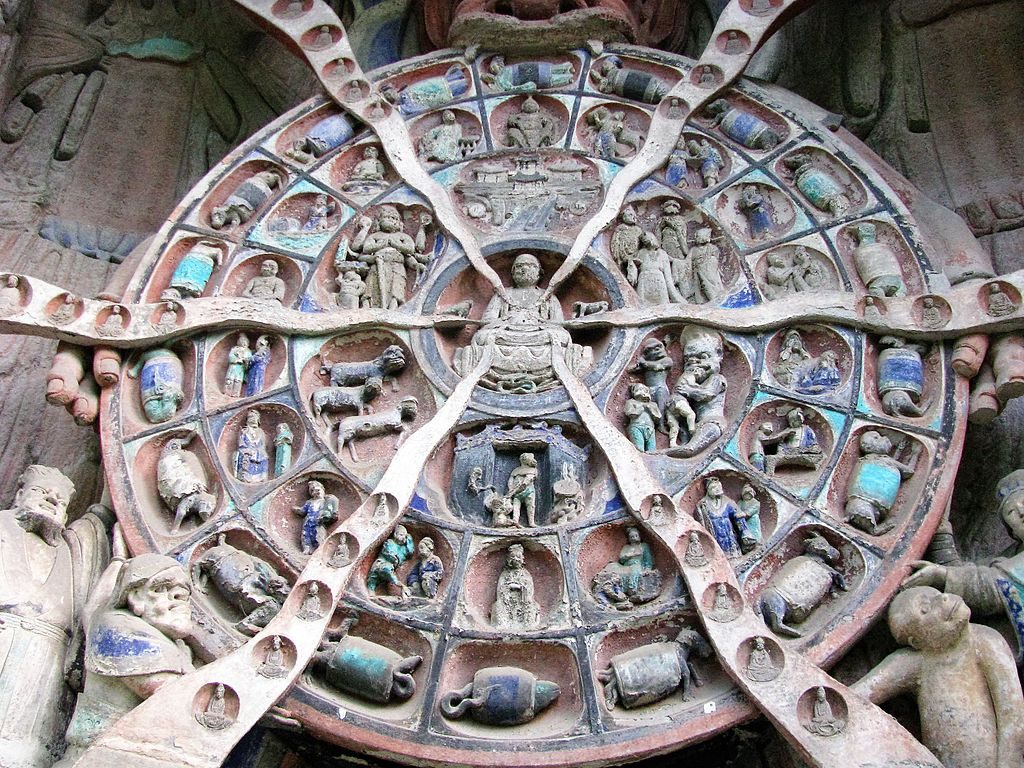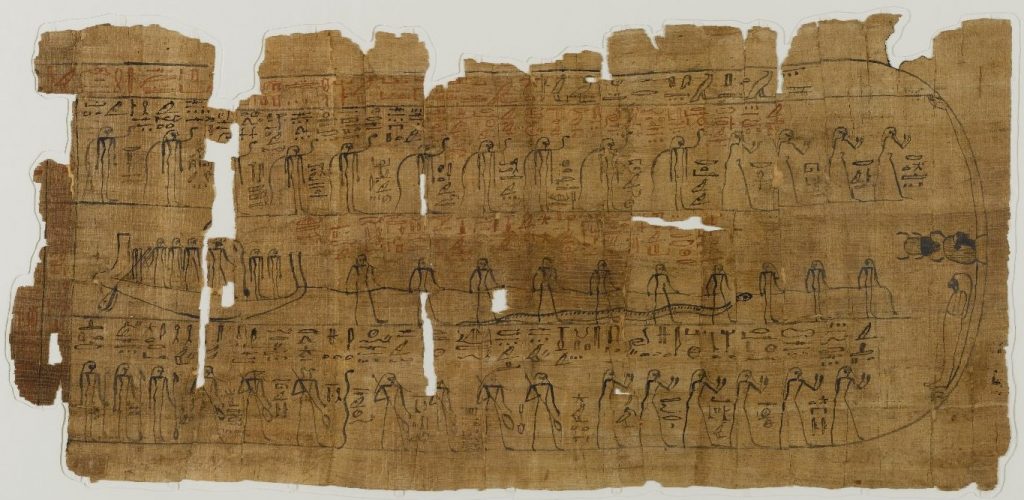From impersonal process to path of purification
Shared by both the orthodox Vedic teachings of the Upanisads and the most prominent non-orthodox sramanic schools, the doctrine of reincarnation was the conceptual framework structuring religious discourse at the time of the Buddha. Though his doctrine of anatman did not fit well with a theory positing a substantial self passing from a body to another, the Buddha did not discard the doctrine outright, and used the doctrine of reincarnation as the framework for his own teachings, redefining reincarnation as rebirth, a dynamic process rather than a substantial one.
The doctrine of reincarnation is also found at the same period in Greek philosophy, especially among the Pre-Socratics – a fact often ignored by scholars of ancient Greece. Moreover, both Greece and India held the same distinctive form of the doctrine – called the tripartite doctrine – which is different from that found among pre-literate traditional cultures.
In The Shape of Ancient Thought, Thomas McEvilley goes through a fascinating analysis of the process which led from the original indigenous form of the doctrine to its tripartite formulation, through a set of cultural processes involving the pre-Aryan/Dravidian refugees from the Indus Civilisation, Mesopotamia, Egypt, and Greece.

McEvilley’s starting point is the tripartite doctrine as it was originally worked out by Theodor Gomperz, who described how the basic cyclic concept of reincarnation – samsara – came to be “loaded” with an ethical dimension – karma, resulting from good or bad actions producing good or bad incarnations in future lives – and a soteriological outcome – moksa – in the form of a release from the round of rebirths.
The original form of the doctrine
Reincarnation as it was first understood in traditional pre-Bronze Age societies describes the process whereby a soul, at the death of the body, was envisioned as reincarnating in another body (human, animal, or even vegetal). Such a view seems to have arisen in association with the shamanic belief in a soul – or several souls – which could separate from the body, but remained close to the earth, entering the bodies of other life-forms. This form of rebirth was an impersonal process beyond the control of the individual involved.
According to McEvilley, it is most probable that the basic form of the doctrine reflected the early view of time as cyclical, with natural processes seen to unfold in repetitive cycles, like the alternance of day and night, the thirty day lunar cycle, or the return of the seasons. Cyclical time is contrasted with linear time, that which we call history, involving an evolutive development and a sense of progress. The step by step displacement of the concept of cyclic time by that of linear time can in fact be witnessed within the evolution of the doctrine of reincarnation. With the Bronze Age, at the same time as mere submission to the cyclical order was rejected, a host of sky deities were called upon to embody the ambitions of those seeking change. The sky then came to represent the notion of a transcendent order, and a new form of reincarnation was developed whereby the souls of the dead would rise to the sky rather than stay close to the earth. The belief was that souls would return to the realm of the gods, from which they had fallen to earth at an earlier time, due to their merit having become exhausted.
Egypt and Mesopotamia
The evolution from the basic reincarnation close to earth to the second form of the doctrine, with the soul rising to the sky, where moral and cognitive laws govern the process, took place in a cultural zone where Mesopotamian and Egyptian cultures interacted. McEvilley describes the process in Egypt, where the Book of the Dead and the Pyramid Texts provide us with interesting clues.

These two sets of funerary texts were designed to provide the deceased with spells and general guidance in the afterlife. McEvilley remarks that the journey of the deceased is patterned after that of the shape-shifting shaman, adding that this journey is structurally similar to a reincarnation process. The soul of the deceased is depicted as going through many transformations, taking human as well as other life-forms. In fact, he notes, Egyptian religion in general “bore a deep shamanic imprint,” involving a dis-membered and re-membered god Osiris who ascends to heaven by means of a ladder – all themes pertaining to shamanic practices. “The powers that the shaman had once exercised in his excursions out of the body into the afterlife were preserved as motifs in the afterlife ritual of the deceased, who was, in effect, to act as his own shamanic guide in the other world, aided by the instructions of the Book of the Dead.”
In the Book of the Dead, the whole journey takes place in the underworld, but in the Pyramid texts, which were meant to be read by the pharaoh, the journey is described as taking place in the sky, and “some passages show his “soul” hovering ambiguously between reincarnationism and rebirth-in-the-afterlife.” There is a sense that “to be reborn at last as pharaoh is to be at the end of the cycle, to have access to the Osiris principle again,” which implies that the shape-shifting journey had been a process of purification, at the same time as it was an ascent to the sky, and the access to the “cosmic” principle of Osiris. The two paths to transcendence which are usually contrasted – that of a direct access to the realm of the gods, as is the case in early Vedic religion – with the soul ascending to heaven with the smoke of the fire ritual – and the lengthy peregrinations through many incarnations which eventually came to prevail in later Indian religion, were still blended in the Egyptian concept of the afterlife.
Compared with the pre-literate concept of reincarnation, the Egyptian formula had acquired a ethical dimension – purification of the soul through successive lives – as well as a political dimension, since incarnation as a king was deemed to be one’s last, immediately preceding ascent to the realm of the gods. Such an ascent, however, stopped short of being a final release, as gods were believe to fall back to earth once their merit had become exhausted.
We cannot help notice that a millennium later, the Indian form of the doctrine of reincarnation includes the same explicit reference to kingship, with the founders of sramanic schools said to be belong to royal families, while Gautama was predicted to become either a cakravartin – a ruler the wheels of whose chariot roll everywhere without obstruction – or a renunciate who, upon enlightenment, would turn the Wheel of the Dharma.
Gosala and the Ajivikas

McEvilley also remarks that Gosala’s doctrine may also be regarded as reincarnation viewed as such as a purification process. When comparing the teachings of Gosala, Mahavira and the Buddha, what the scholars have usually emphasised is Gosala’s insistence that the process was a deterministic one, involving 8,400,000 incarnations – in other words, a “big number” covering “all” life-forms – and that no ethical practice could secure an early release. This amoral view seemed to indicate that the Ajivika were only seeking special powers, and were not really interested in an escape from the suffering of an incarnation on earth. What McEvilley is stating is that, for Gosala, as was the case in the Egyptian formula, the serial reincarnation of the soul into all life-forms was sufficient to carry out the purification process. The soul was “thus gradually universalized, obtaining knowledge of every mode of existence from inside. In Gosala’s view, no effort could hasten the end of the process. The ethical value of one’s behaviour meant nothing; the step-by-step initiation into universality would have its effect regardless.”
What Gosala involuntarily tells us, as well, is that his own formula originated from Mesopotamia. How? He uses a variant of the number 84, which is known to be the marker of a Sumerian origin. McEvilley regards the teachings of the Ajivika religion as India’s oldest religion, most probably going back to the Indus Valley Civilisation, which is known to have had trading relations with Mesopotamia. The Indus culture is also associated with the practice of yoga, which would play a key role as a meditation practice leading to early release, as taught by Mahavira and the Buddha, but it is unlikely that yoga was used for this purpose in the Indus culture itself. As long as the Indus script remains undeciphered, it will not be possible to know with any certainty the religion of the people living in a region which included today’s Pakistan, Afghanistan, and part of India, covering not only the valley of the Indus, but also that of the Sarasvati river, which eventually dried up, bringing about the collapse of the civilisation around 1700 BC, sending refugees to other parts of the subcontinent, especially eastward to the Ganges Valley.
The tripartite doctrine
The tripartite version of the doctrine – which introduces the possibility of an early release from the round of rebirths – was worked out in India, in the context of what McEvilley describes as a “meltdown” of Indian religious thought, which compelled “the Aryan establishment” to admit “tribal influences” from Pre-Aryan indigenous peoples “along with renewed Near Eastern influences.”
The analysis of the doctrine of reincarnation continues in “Reincarnation in the Upanisads.”
Source
Thomas McEvilley – The Shape of Ancient Thought (2002)

